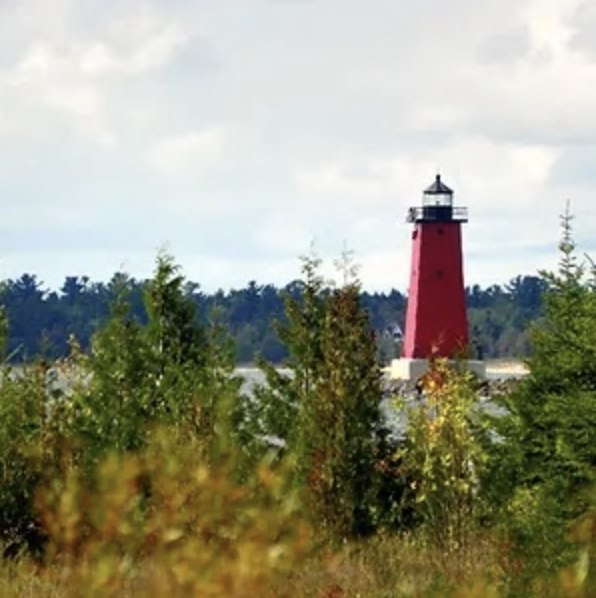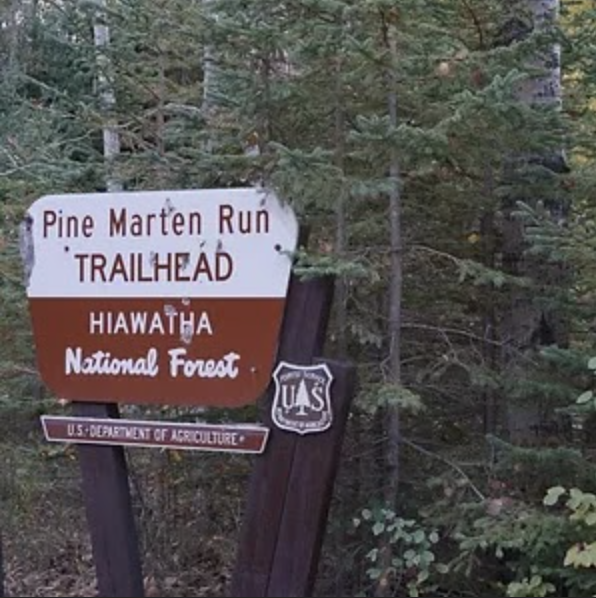
Schoolcraft Tourism & Commerce
Manistique East Breakwater Light is on the National Register of Historic Places.Editor’s note: This is the 3rd in a series of election year county profiles in collaboration with the MSU Journalism School, American Communities Project, Detroit Free Press and Capital News Service.
By JACK ARMSTRONG, WAJEEHA KAMAL, MAYA MOORE AND SHEALYN PAULIS
Capital News Service
MANISTIQUE − When you ask residents of Schoolcraft County in the Upper Peninsula to talk about their home, they’ll usually first mention the scenic environment and how close they are to Lake Michigan.
“Our natural beauty is just unbelievable. How blessed we are to live in this,” county Commissioner Paul Walker said.
But the same rural qualities they value present difficulties that other, larger counties in the state don’t face, something that affects the area’s concerns, solutions and political landscape.
A large portion of the county lies within the 880,000-acre Hiawatha National Forest. Aside from Christmas, the opening day of deer firearms hunting season is the most popular holiday. Manistique, the county’s only city, lies along the northern shore of Lake Michigan and features a small downtown lined with shops and restaurants — and the county’s only hospital.
“We have one grocery store,” said Alisa Calhoun, the child welfare supervisor for the Sault Ste. Marie Tribe of Chippewa Indians. “We have as many bars as we do churches.”
The county has about 8,000 residents, 9% of whom belong to the Sault Ste. Marie Tribe.
The American Communities Project, which groups U.S. counties into typologies based on a variety of data, classifies Schoolcraft as a Graying Community. Such communities have a quarter or more of their population over age 65 and only 18% under 18.
U.S. Census numbers show nearly 29% are 65 and older, compared with 17.3% nationwide.
While the county does have young residents, they don’t always stay after high school, or sometimes leave and come back.
That’s the path Calhoun took. She was born in Schoolcraft County and left for college, but returned to work for the tribe.
She said one issue the community faces is lack of child care options for families.
“There’s no licensed day care center,” she said. “What you find in these small communities is a lot of family members and relatives, friends that also live nearby that support youth for child care. You have a lot of children cared for by aunts, uncles, grandmas, grandpas.”
Since much of the land is federally owned, land available for development and housing is limited.
The county receives Payments in Lieu of Taxes funding from the federal government to offset property taxes lost from nontaxable federal lands.
Housing availability and affordability are growing concerns. The county remains a tourist hot spot, and almost half its housing units are seasonally occupied or rented to tourists, according to the Central Upper Peninsula Planning and Development Regional Commission.
Victoria George, the executive director of Schoolcraft Tourism and Commerce, said another big worry associated with rising housing costs is interest rates.
“A lot of the (property) sales are cash sales. Not a lot of people want to do a mortgage at this high of a rate,” George said. “So if you’re a first-time homebuyer, it’s making it more difficult to be able to purchase a home, if you can find a home, because the interest rates are high.”
In 2020, 65.12% of Schoolcraft County voters chose then-President Donald Trump when many other Michigan counties turned Democratic.
“We’re a red county, so to speak,” Walker said.
Many residents express concern about Social Security and Medicaid benefits and are afraid there won’t be enough left for them after paying into the system their entire working lives, he said. Those worries are exacerbated by inflation, which Walker said hits Schoolcraft hard.
“Our gas prices are extremely high, our food prices are high and, of course, wages are stagnant too,” he said.
George said she hoped for new presidential candidates altogether.
“A change in leadership maybe, I would say, in our government, not in my local government,” she said. Calhoun said she’s reluctant to get into politics and unconvinced her vote in a presidential election matters.
“I don’t know that it touches our community,” she said. “We are such a small town, I can only focus on my bubble and my community and my job and my family.”
When most community members live paycheck to paycheck, being involved in politics isn’t at the top of their priorities.
Kimberly Hampton, the secretary and a member of the tribe’s board, said, “People who live in the community areas have to primarily focus on survival mode.”
Gun ownership is one issue residents take an interest in.
“A lot of people really feel they need protection. We don’t have the law enforcement capabilities that other counties do, so people feel they feel that they need to protect their family and property,” said Walker.
The county’s strong hunting culture is also a significant factor in gun ownership. About 12% of adults above 21 hold concealed pistol licenses. Over 20% of those 18 and older possess hunting licenses, according to the latest data.
In 2020, the county Board of Commissioners voted to make Schoolcraft a Second Amendment sanctuary county. The resolution states that the board would not reduce county funding for a prosecutor or sheriff who refuses to enforce state gun laws.
To combat stagnation, the tight-knit community is committed to creating opportunities for youths, according to Hampton.
As part of a collaboration with a local credit union, students in the middle and high school introductory business class renovated a local abandoned building into a successful student-run coffee shop.
Hampton said the shop “ended up creating scholarships at the end of their first year to give to the high school students.”
“That’s what we are trying to do to try to keep them involved and not fall into the intergenerational poverty that we have around here.”
And projects like that are part of the tight-knit community’s fabric. Far from Washington, D.C., and even Lansing, community leaders and changemakers are coming up with their own solutions.

Schoolcraft Tourism & Commerce
The 26-mile Pine Marten Run Trail is in the Hiawatha National Forest’s Ironjaw Semi-Primitive Area. Credit.